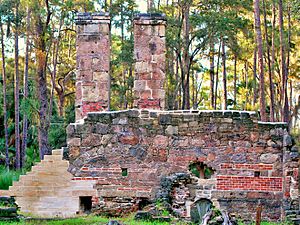Douglas Dummett facts for kids
Quick facts for kids
Douglas Dummett
|
|
|---|---|
| Member of the Legislative Council of the Territory of Florida representing St. Johns County | |
| In office 1843–1845 |
|
| Member of the Florida House of Representatives from Mosquito County | |
| In office 1845–1845 Serving with Algernon S. Speer
|
|
| Preceded by | Thomas T. Russell |
| Succeeded by | Mosquito County split and renamed |
| Personal details | |
| Born | 1806 Barbados |
| Died | 1873 Florida |
| Political party | Democratic |
| Spouses | Frances Hunter (m. 1837, div. 1844), Leandra Fernandez |
Douglas Dummett (1806–1873) was an important person in early Florida history. He owned a large farm and helped develop the citrus industry. He also served in the government. In 1843, he was part of the Legislative Council of the Territory of Florida. Later, in 1845, he was a member of the Florida House of Representatives.
Contents
Early Life in Florida
Douglas Dummett was born in 1806. His parents, Thomas Henry and Mary Dummett, had eleven children. Their family moved from Barbados in 1817. After living in New Haven, Connecticut, they moved to Florida in 1821.
Douglas's father bought a large farm called "Carrickfergus." It was located on the Tomoka River. He later bought another large farm of about 2,000 acres. This farm had houses and other buildings. Douglas's father brought a special steam boiler engine from Barbados. He used it to process sugarcane grown on the farm. He also had a sugar mill and a rum distillery built.
During the sugarcane season, many workers helped at the sugar mill. They heated and processed the sugarcane juice. This made molasses, which was stored in large tanks. The molasses was then used to make rum. Local Native Americans would trade wild game for the sugar products.
Douglas's sister, Anna, wrote about their home. It was a big log house with a roof made of palmetto leaves. Large oak trees with Spanish moss shaded the yard. The house was nicely furnished. It had a big fireplace and elegant furniture.
Douglas took over running the farm from his father in 1828. He managed it until 1835. Douglas also became the first postmaster in the Tomoka area from 1833 to 1836.
Serving During the Seminole War
In 1836, Florida was in the middle of the Second Seminole War. Douglas Dummett joined a local group of soldiers called the Mosquito Roarers. He became a Captain in this group. He was hurt while defending a nearby sugar farm. This happened during a battle at Dunlawton Plantation.
After he got better, Douglas married Frances Hunter in 1837. In the same year, he became a member of the Territorial Council.
New Home in New Smyrna
Douglas Dummett did not like living in the city of Tallahassee. So, he moved back to his home near Mosquito Lagoon. In 1843, he started a new farm near New Smyrna. He also became a deputy collector for the nearby port.
Developing Florida's Citrus Industry
Douglas Dummett eventually moved his family to a quiet area in Brevard County. This was near the Indian River. He became very interested in growing oranges.
It is believed that Douglas started shipping oranges as early as 1828. These might have been from wild orange trees. However, he is famous for finding sweet orange trees. He learned to graft sweet orange buds onto the roots of common sour orange trees. This helped grow better oranges.
Douglas's orange grove was protected by two large lagoons. This mild climate helped his trees survive a very cold winter in 1835. This freeze killed many other orange groves in Florida.
Dummett's oranges were known for their great taste. They sold for a high price in New York. He shared his knowledge about growing citrus with new settlers. He taught them about grafting and taking care of the trees. He lived near his orange grove until he passed away in 1873.
His methods for growing oranges spread. By the late 1800s, other growers in Florida used his techniques. In 1930, the government had to make a rule. It stopped growers from other parts of Florida from calling their oranges "Indian River Citrus." This showed how special Dummett's oranges were.
Images for kids



